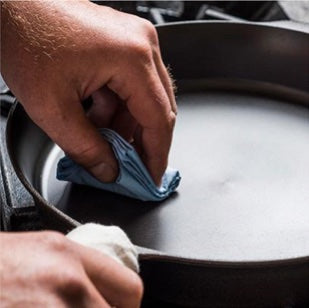Why are cast iron skillets so expensive?
In recent years, vintage cast iron pans have seen a huge spike in interest. People are going to great lengths to track down old beauties made by classic brands like Griswold and Wagner in online bidding wars, at yard and estate sales, or rummaging in grandma's attic. Why? Superior production levels.
Vintage pans were first hand poured into molds, carefully cooled, and then smoothed and polished by hand. The results were lighter, slicker, smoother cast iron skillets. Because these pans were so well made and cast iron is a durable material, many pieces have been restored and enjoy second lives in contemporary kitchens. And, yes, sourcing and restoring a vintage cast iron pan can get expensive.
The revived interest in vintage cast iron cookware has sparked a wave of craft cast iron forges—we stand proudly among them—who are creating a new generation of cast iron skillets using old production methods. Field skillets are machined and polished by hand. This not only removes uneven textures, but it also reduces extra weight and improves the overall form, giving cooking enthusiasts a cast iron skillet that is light, smooth, and ergonomic.
You can get inexpensive good-quality cast iron pans. However, mass-produced skillets do not go through the extra polishing process and tend to be heavier, with a grainy, porous surface that can’t compete with handcrafted cast iron.
While we are on the question of price, it's worthwhile to note that when you buy a new-generation cast iron craft piece, you will be buying it for a lifetime.
Here is a comparison: A good quality non-stick skillet (PTFE coated over stainless steel or hard-anodized aluminum) is not cheap; on the low end, you are looking at at least $30 to $40. If you use your skillet carefully—no overheating, only using silicone and wood utensils, washing with a soft sponge—you will need to replace them every 3 to 5 years. If you are rough or begin to see nicks and scratches, you could be replacing them every 1 to 3 years.
Cast iron is virtually indestructible; we can pretty much guarantee that you won't be replacing it in your lifetime.
In the end, when you buy a high-quality, American-made cast iron skillet that has gone the extra step of bringing it closer to its prized ancestors, you are making a very sound investment.













